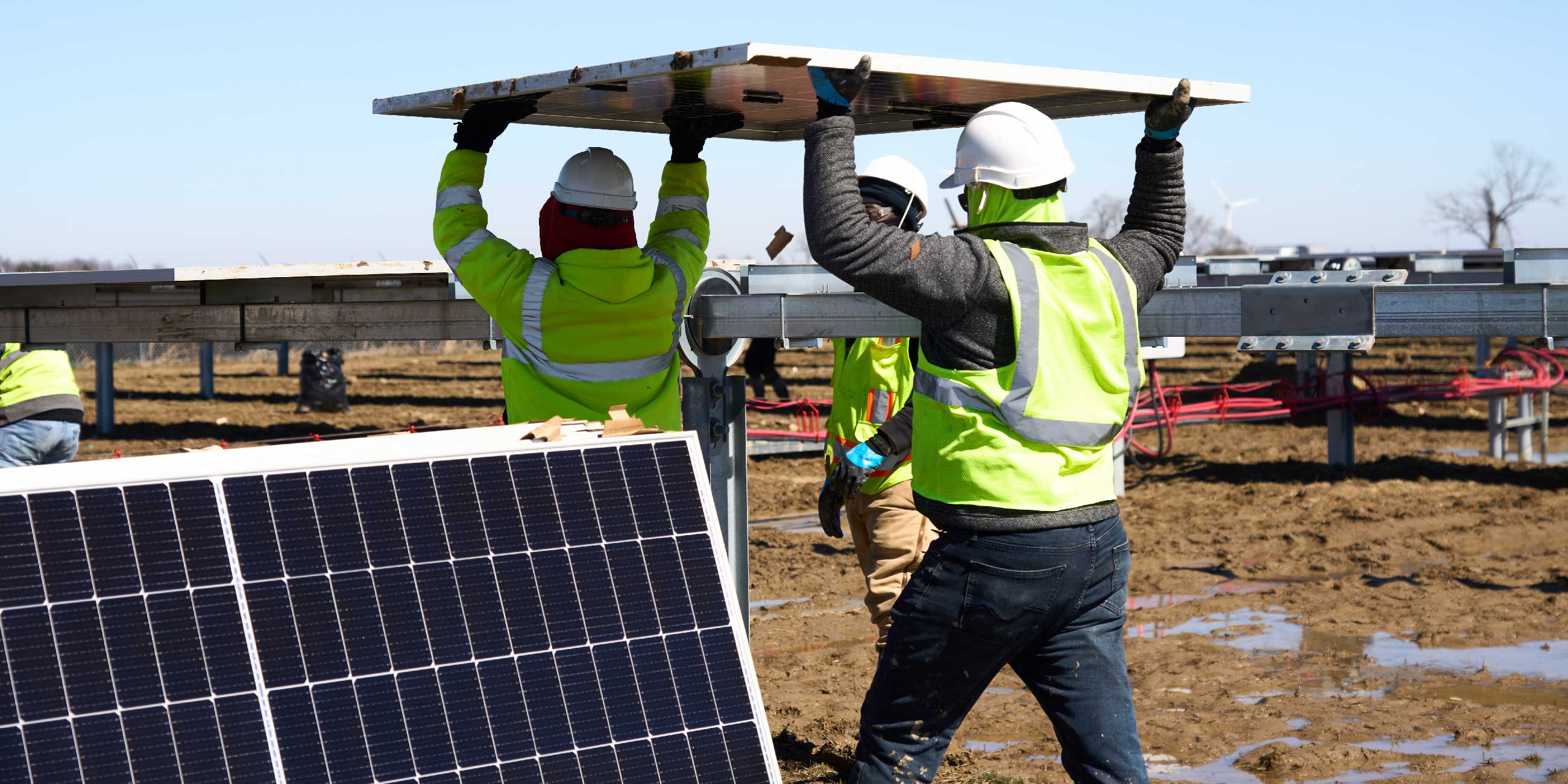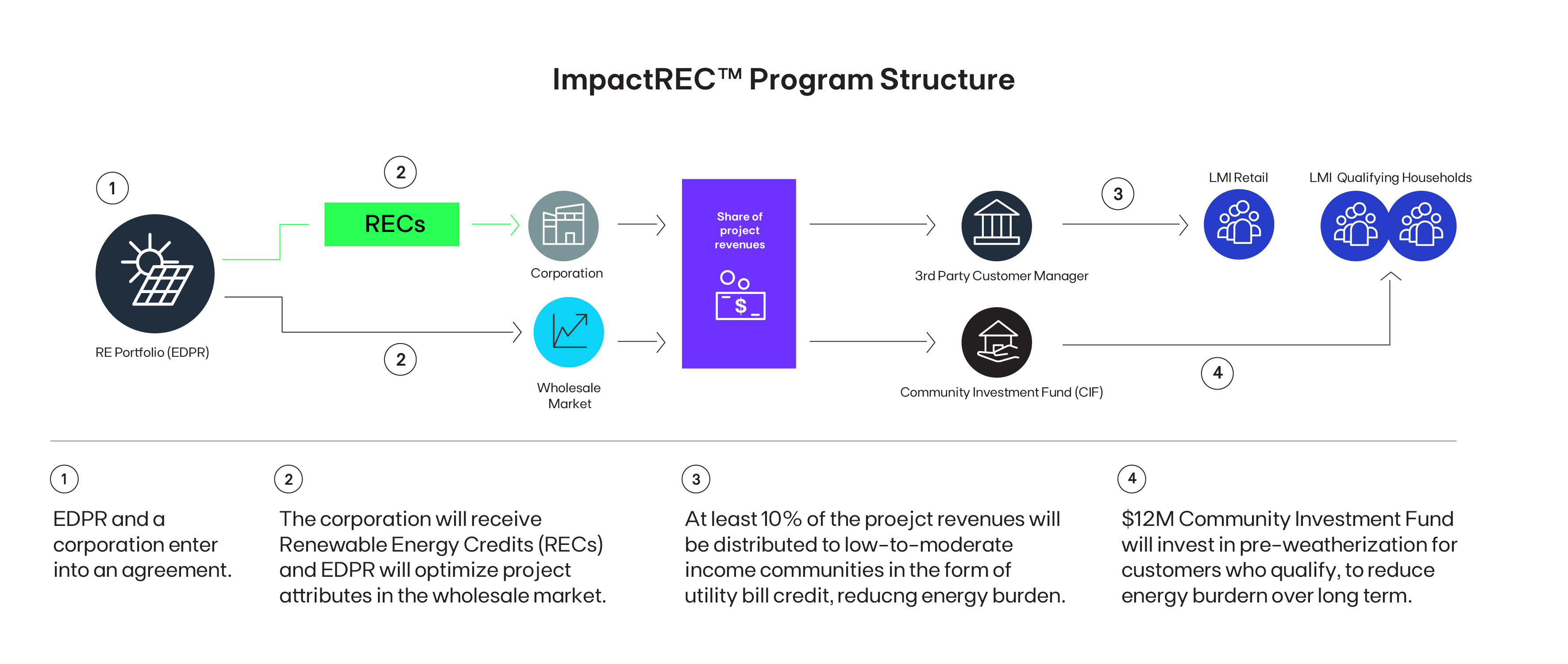
Expanding the Benefits of Clean Energy Through an Innovative ImpactREC™ Program

EDPR NA DG is actively working with corporate players across the US through its ImpactREC™ program, which is revolutionizing how distributed generation investments can directly impact local communities.
Approximately 2/3 of Americans are ineligible to enjoy the benefits of participating in rooftop solar, making solar energy a relatively inaccessible product. Considering the economic benefits of community and rooftop solar, especially with over 30 million households strained under a high energy burden, it becomes critical to remove barriers to solar access for underserved communities. Some states, mainly those in the Northeast and mid-Atlantic, provide low-income customers with access to community solar through legislation and subsidies. Community solar, according to the Coalition for Community Solar Access, refers to local solar facilities shared by multiple community subscribers (typically households and small businesses) who receive credit on their electricity bills for their share of the power produced.
While these programs have created opportunities to participate in locally sited clean energy projects in a meaningful way, the existing community solar structure relies too heavily on legislative action and state subsidies to provide energy bill savings to residential and small commercial consumers. So, we set out to accomplish three goals:
Deliver value to end-users, especially those typically harmed by fossil fuel power generation (low-to-moderate income (“LMI”) communities)
Create a community-based solar program that is not geographically or legislatively constrained; and,
Ensure that program benefits reduce energy burden for LMI customers and maximize local impact.
A Case Study: Reducing barriers to entry and socializing the benefits of clean energy through an ImpactREC™ Program
In the Summer of 2021, Google and EDP Renewables NA DG, the distributed generation subsidiary of EDPR NA kicked off efforts to rethink the way that large corporations and developers interact with community stakeholders. The focus was to extend benefits to local communities specifically in geographies where state-level incentives and policies are not available. The product of our collaboration is a first-of-its-kind opportunity for corporate engagement in distributed generation that directly invests in, and provides long-term benefits to, LMI households and communities. Funding comes, in part, through Google’s purchase of a premium renewable energy credit dubbed “ImpactREC™” over the course of fifteen years, being generated from participating solar power plants developed by affiliates of EDPR NA DG.This funding in turn directly goes towards underserved communities.
“RECs” are renewable energy credits—the ‘green’ part of renewably produced energy that can be sold separately from the energy itself and a way of certifying that the power produced and used was done so in a sustainable, renewable, way. ImpactREC™ on the other hand, carries with it additional covenants that ensure the economic benefits are transferred directly to community stakeholders. In this specific deal we ensure impact flows through to historically marginalized communities in three meaningful ways:
Reducing energy burden sustainably through a community investment fund (“CIF”),
10% of energy revenues flow to LMI customers as a bill credit, and
Siting requirements to ensure maximum benefits flow to the most vulnerable.
In addition to this, EDPR NA DG also provides customers such as Google the administrative processing services for RECs, as well as associated trading services if there is interest to go that route.
All told, Google and EDPR NA DG expect the first framework to yield 500MWAC of distributed solar by 2028 without EDPR NA DG (or any adoptive developers) achieving excess windfalls at the customer’s expense.
Achieving scale without the need for additional legislation
This new structure allows us to build a faster-to-market, scalable, solar program that can be deployed to any U.S. State that is subject to the Federal Energy Regulatory Committee’s (the “FERC”) rules. Three key pillars that this program is founded upon, and that can be replicated elsewhere, are:
Premium fixed revenue contract that smooths out the inconsistent (seasonal) cash flows, in this case in the form of Renewable Energy Credit payments;
2. Processing the financial benefits associated with REC payments and transferring them to low-income customers in a form that directly reduces utility bill costs; and
Flexibility to optimize portfolio performance over the duration of the contract and ensure continued delivery of benefits to the community.

The mechanics above already exist in current transactions and regulatory programs, but they don’t necessarily work together to deliver an optimized outcome. We are excited to share additional details in future blog posts and explore the ImpactREC™ program structure in more detail. Our goal is to iterate on this work in collaboration with new customers and in various communities.
Community investment and empowering environmental justice
We set out to extend the benefits of clean energy to underserved communities and change the way community-based clean energy projects are developed, ensuring that project investment flows down to the communities we serve. By providing direct energy bill credits, we are working to reduce short-term energy burden (the amount of a customer’s income that they must allocate towards energy costs) and help households get out of the vicious cycle of energy poverty.4
Through a Community Investment Fund (CIF), we will invest in pre-weatherization upgrades that put households on the path to energy efficiency and resiliency. The CIF will work alongside the bill credits to provide direct savings to customers and reduce their energy spend.
In addition to bill credits and energy efficiency programs, the portfolio of projects we develop will create local jobs and tax revenues directly in the communities that need them the most, not only reducing their energy burden but improving their health as well5. Through EDPR NA DG’s collaboration with corporate offtakers, such as Google, we have established a rigorous set of siting standards to ensure that at least 35% of the projects are placed in and around the communities that need these benefits the most.
By creating a program that aligns with the values of local communities rather than pure financial benefit, EDPR NA DG is looking to change the paradigm and acceptance of solar, ideally creating a positive feedback loop that can be emulated by others in the future. Ultimately, this initiative and related program reinforces for us at EDPR NA DG why we spend countless hours developing distributed generation projects. We look forward to collaborating and working with others in the industry in creating an impact that produces a “win-win” for not only corporations, but communities across the U.S.
Contact Information:
Eric Misbach, eric.misbach.edp.com, Connect on LinkedIn